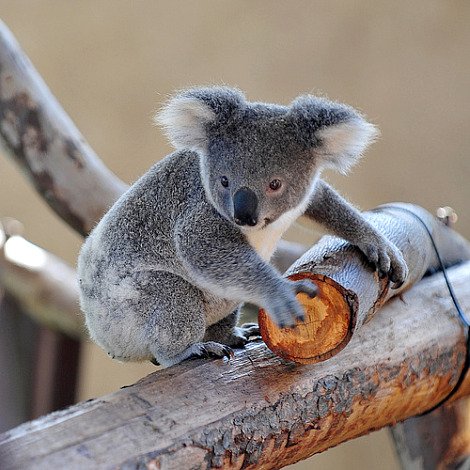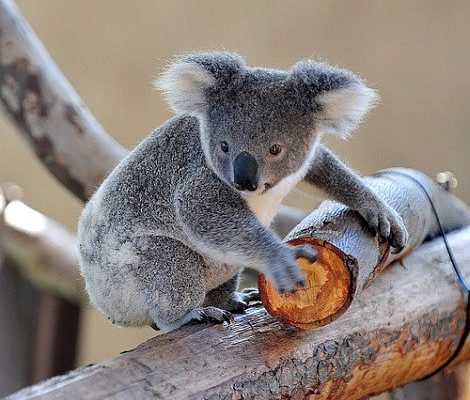
Raising a baby koala is a bit like being a single parent—there’s a lot of responsibility, and every day brings new challenges. From nurturing their young to teaching them how to find food, koala mothers put in a ton of effort. Let’s dive into the world of koala parenting and discover the tender ways these creatures raise their young in the wild.
The Birth of a Baby Koala
Koalas typically give birth to just one baby, known as a joey, after a gestation period of about 35 days. That’s not long at all! Once born, the joey is incredibly tiny—about the size of a jellybean—and completely helpless. This little creature needs a lot of care, and that starts right after it’s born.
Here’s where it gets interesting: after birth, the joey climbs its way into its mother’s pouch. This pouch is a safe haven, protecting the joey while it continues to develop. As it grows, the pouch becomes its world— a cozy space where it will stay for six months. Can you imagine living in your mom’s pocket for half a year? During this time, the joey remains attached to its mother, often sleeping and feeding, all while learning the ropes of life outside the pouch.
Feeding the Young
One of the most crucial aspects of raising a joey is feeding. Koalas are herbivores, and their diet mainly consists of eucalyptus leaves, which are not only unique but also quite tough for young ones to digest. So, how does the mother koala ensure her baby gets the right nutrients?
When the joey is around six months old, it starts to eat solid food, but it still relies heavily on its mother’s milk at this stage. The mother produces a special type of milk that helps the joey develop. Interestingly, the composition of this milk changes as the joey grows, providing exactly what it needs at each stage. It’s like having a personalized meal plan—how cool is that?
As the joey gets older, it learns to munch on eucalyptus leaves alongside its mother. This is a vital part of their growth, as they not only get nutrition but also learn how to find the best leaves to eat, which will become essential for their survival later on.
Learning Life Lessons
Once the joey starts venturing out from the pouch, it enters a world full of discoveries. This is where the mother koala plays the role of a teacher. Here’s the thing: raising a koala isn’t just about keeping them fed; it’s also about teaching them essential skills for survival.
The mother demonstrates how to navigate tree branches, which can be quite tricky. Young koalas are curious, often clumsily climbing around, and they learn by watching their mother. They learn to recognize the various types of eucalyptus leaves and which ones are safe (and tasty!) to eat.
During this time, the joey also begins to interact with its environment. It might play with leaves or try to imitate its mother’s movements. This playful and exploratory phase is crucial as it builds confidence and prepares them for a life on their own.
Independence and Leaving the Nest
As the joey approaches its first birthday, it’s time for a big change. This is the moment when it transitions from being a dependent baby to an independent young koala. Typically, joeys will start to leave their mother’s side and explore the world on their own.
You might be wondering: what does independence look like for a koala? Well, it means they start finding their own food and making their own way up the trees. This is a critical phase because it teaches them how to survive without their mother. While they might still stay close to her for a while, they are learning to be self-sufficient.
Eventually, around 12 months old, the joey will completely wean off its mother’s milk and venture out to establish its territory. It’s a bittersweet moment because the bond between mother and joey is incredibly strong, but it’s part of nature’s design for the species.
Challenges in the Wild
Unfortunately, raising young koalas is not without its challenges. The wild can be a tough place for these cute marsupials. Factors like habitat loss, diseases, and climate change significantly impact their ability to thrive.
For example, as eucalyptus forests are cleared for urban development or agriculture, the food source for koalas shrinks. This leads to competition for food and can make it difficult for mothers to find enough nutrition while raising their joeys.
Additionally, diseases like chlamydia can affect koalas, impacting their reproductive health. This means that fewer healthy joeys are born, which puts pressure on the population. Conservation efforts are crucial to help protect these animals and ensure they continue to thrive in the wild.
The Importance of Conservation
Protecting koalas and their habitats is essential for their survival. Many organizations are working tirelessly to conserve these beautiful creatures and the environments they live in. But you might think, “What can I do to help?”
There are several actions you can take to support koalas:
- Raise awareness: Share information about koalas and their needs on social media or with friends.
- Support conservation groups: Donate to organizations working to protect koalas and their habitats.
- Plant eucalyptus trees: If you have the space and conditions are right, consider planting eucalyptus trees to provide a food source.
Every little bit helps! By getting involved, you play a part in ensuring future generations can enjoy the sight of these amazing animals.
Koalas may seem like simple creatures, but the way they raise their young is a testament to nature’s complexity. From the cozy life inside the pouch to their gradual journey to independence, every step is filled with affection and learning.
As we’ve explored, koala mothers are diligent caregivers, navigating the challenges of the wild while ensuring their young have the skills they need for survival. By understanding their fascinating parenting methods and the hurdles they face, we can better appreciate the delicate balance of life in the wild and contribute to preserving it. So next time you think of a koala, remember the incredible journey these furry beings undertake to raise their young.

